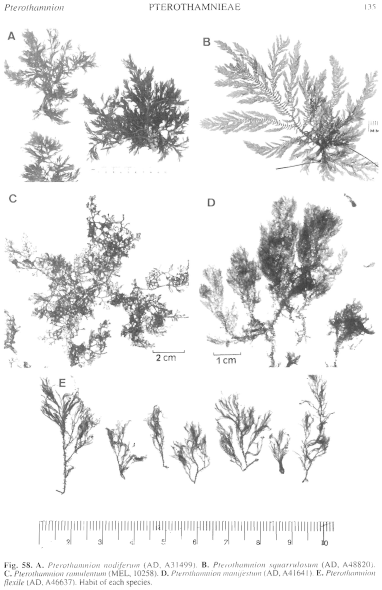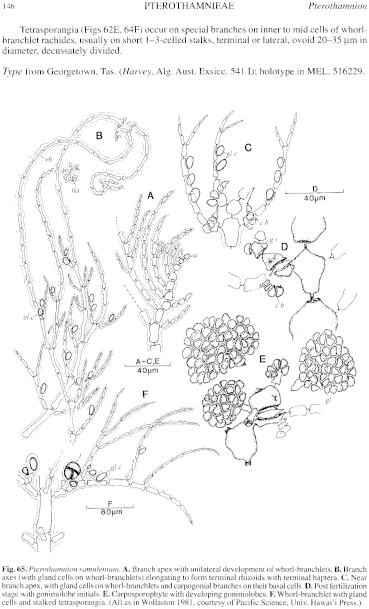|
|
|
|
|
|||||||||||
|
Electronic Flora of South Australia Species Fact Sheet
Phylum Rhodophyta – Order Ceramiales – Family Ceramiaceae – Tribe Pterothamnieae
Selected citations: Athanasiadis 1996: 71, fig. 24.
Synonyms
Glandothamnus ramulentus Wollaston 1981: 114, figs 12–18, 41.
Callithamnion plumula (Ellis) Lyngbye sensu Hooker & Harvey 1847: 412. Harvey 1859b: 333; 1863, synop.: liii. Sonder 1881: 10.
Antithamnion plumula (Ellis) Thuret sensu Lucas 1929a: 25. May 1946: 123.
Thallus (Fig. 58C) medium red-brown, erect, 2–5 cm high, complanately branched and flexuous, with alternate lateral branches usually every 5–6 axial cells, ecorticate throughout. Holdfast small, rhizoidal; epilithic. Structure. Apical cells 6–9 µm in diameter and L/D 1–2, axial cells enlarging to 150–450 µm in diameter and L/D 1–2 (–3) in lower axes, each with (2–) 4 whorl-branchlets of similar development (transverse ones slightly shorter) initiated unilaterally (Fig. 65A) at branch apices, occasionally branch apices develop into attachment rhizoids (Fig. 65B). Whorl-branchlets (Fig. 63D, E) 250–600 (–850) µm long, adaxially branched (occasionally opposite) from lower and mid cells of the curved rachides, with simple or branched pinnules 300–600 µm long; basal cells of rachis 30–45 µm in diameter and L/D 1.5–2 (mid cells L/D 2–3), tapering to subterminal cells 8–12 µm in diameter and L/D 1–2, terminal cells mucronate; gland cells (Figs 63D. 65B) prominent on cells of the whorl-branchlets, ovoid, oblique, 12–20 µm in diameter. Lateral branches arising from axial cells or the basal cells of whorl-branchlets. Cells uninucleate; rhodoplasts elongate in small cells, becoming ribbon like in larger cells.
Reproduction: Gametophytes probably dioecious. Carpogonial branches (Fig. 65C) borne on basal (= supporting) cells of whorl-branchlets, with 1 to several at branch tips. Auxiliary cell cutting off a gonimoblast cell (Fig. 65D) which forms a terminal and later lateral gonimolobes (Figs 63C, 65E) 150–300 µm across of ovoid to angular carposporangia 8–20 µm across, without involucral whorl-branchlets from lower axial cells. Spermatangia (Fig. 63D) in branched clusters on cells of pinnules.
Tetrasporangia (Figs 62E, 64F) occur on special branches on inner to mid cells of whorl-branchlet rachides, usually on short 1–3-celled stalks, terminal or lateral, ovoid 20–35 µm in diameter, decussately divided.
Type from Georgetown, Tas. (Harvey, Alg. Aust. Exsicc. 541 I); holotype in MEL, 516229.
Selected specimens: Investigator Strait, S. Aust., 41 m deep (Watson, 14.i.1971; AD, A38159), 31 and 33 m deep (Watson, 24.i.1971; AD, A40998 and A41084). Oedipus Point, West I., S. Aust., 21–26 m deep (Shepherd, 8.x.1966; AD, A30874). Port Phillip Heads, Vic. (Wilson, 17.i.1893; MEL, 10281 and 6.ii.1893; MEL, 10258). Bombay Rock, Tamar Est., Tas. (Perrin, 24.ii.1948; AD, A46358)?
Distribution: Investigator Strait, S. Aust. to N.S.W. (May 1946, p. 123) and the N coast of Tasmania and D'Entrecasteaux Channel.
Taxonomic notes: P. ramulentum (as Antithamnion plumula) was recorded by May (1946, p. 123) as prevalent on the N.S.W. coast from Batemans Bay to Jervis Bay, in 20–50 fathoms. It appears to be confined to deep water. May and also Athanasiadis (1996, p. 72) have also recorded it from D'Entrecasteaux Ch., Tasmania.
References:
ATHANASIADIS, A. & KRAFT, G.T. (1994). Description of Pterothamnion squarrulosum (Harvey) comb. nov. from south-eastern Australia and southern New Zealand, with a taxonomic re-assessment of the genera Pterothamnion, Platythamnion & Glandothamnus (Ceramiaceae, Rhodophyta). Eur. J. Phycol. 29, 119–133.
ATHANASIADIS, A. (1996). Morphology and classification of the Ceramioideae (Rhodophyta) based on phylogenetic principles. Opera Botanica No. 128, pp. 1–216.
HARVEY, W.H. (1859b). Algae. In Hooker, J.D., The Botany of the Antarctic Voyage. III. Flora Tasmaniae. Vol. II, pp. 282–343, Plates 185–196. (Reeve: London.)
HARVEY, W.H. (1863). Phycologia Australica. Vol. 5, Plates 241–300, synop., pp. i-lxxiii. (Reeve: London.)
HOOKER, J.D. & HARVEY, W.H. (1847). Algae Tasmanicae. Lond. J. Bot. 6, 397–417.
LUCAS, A.H.S. (1929a). The marine algae of Tasmania. Pap. Proc. R. Soc. Tasm. 1928, 6–27.
MAY, V. (1946). Studies on Australian marine algae. II. Proc. Linn. Soc. N.S.W. 70(3–4), 121–124.
SONDER, O.W. (1881). In Mueller, F., Fragmenta Phytographiae Australiae. Supplementum ad volumen undecinum: Algae Australianae hactenus cognitae, pp. 1–42, 105–107. (Melbourne.)
WOLLASTON, E.M. (1981). Descriptions of two new genera, Scageliopsis and Glandothamnus (Ceramiaceae, Rhodophyta), including five previously undescribed species from southern Australia. Pacific Sci. 34, 109–127.
The Marine Benthic Flora of Southern Australia Part IIIC complete list of references.
Publication:
Womersley, H.B.S. (24 December, 1998)
The Marine Benthic Flora of Southern Australia
Rhodophyta. Part IIIC. Ceramiales – Ceramiaceae, Dasyaceae
©State Herbarium of South Australia, Government of South Australia
Illustrations in Womersley Part IIIA, 1998: FIGS 58C, 63 C–E, 65.

Figure 58 enlarge
Fig. 58. A. Pterothamnion nodiferum (AD, A31499). B. Pterothamnion squarrulosum (AD, A48820). C. Pterothamnion ramulentum (MEL, 10258). D. Pterothamnion manifestum (AD, A41641). E. Pterothamnion flexile (AD, A46637). Habit of each species.

Figure 63 enlarge
Fig. 63. A, B. Pterothamnion manifestum (AD, A41641). A. Branches with gland cells on pinnules, and two carposporophytes. B. Male thallus with spermatangial clusters. C–E. Pterothamnion ramulentum (C, E, AD, A41084; D, AD, A30874). C. Carposporophyte. D. Spermatangial clusters on cells of pinnae, with gland cells. E. Branches with tetrasporangia.

Figure 65 enlarge
Fig. 65. Pterothamnion ramulentum. A. Branch apex with unilateral development of whorl-branchlets. B. Branch axes (with gland cells on whorl-branchlets) elongating to form terminal rhizoids with terminal haptera. C. Near branch apex, with gland cells on whorl-branchlets and carpogonial branches on their basal cells. D. Post fertilization stage with gonimolobe initials. E. Carposporophyte with developing gonimolobes. F. Whorl-branchlet with gland cells and stalked tetrasporangia. (All as in Wollaston 1981, courtesy of Pacific Science, Univ. Hawai'i Press.)

|
Email Contact: State Herbarium of South Australia |

|